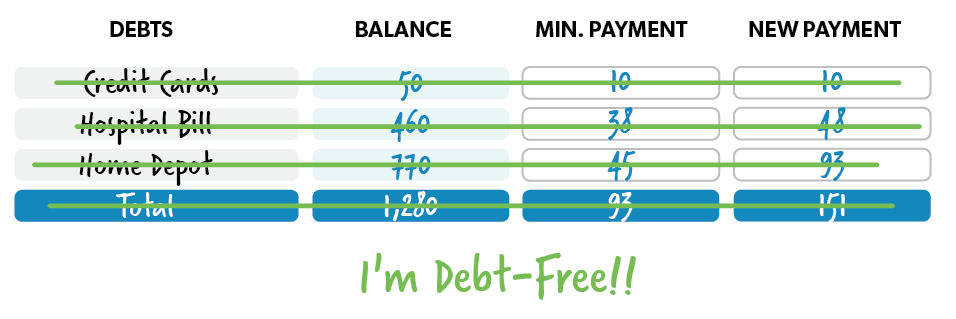What could you do if you didn’t have a single debt payment in the world? That’s right—no student loans, car payments or credit card bills. You could free up an extra $300, $500 or maybe even $800 in your budget every month! Ah, that’s the debt-free life.
The quickest way to make your debt-free dream a reality is to use the debt snowball method.
What Is the Debt Snowball Method?
The debt snowball method is a debt reduction strategy where you pay off your debts in order of smallest to largest, regardless of interest rate.
But even more than that, the debt snowball is designed to help you change your behavior with money so you never go into debt again. It gives you power over your debt—because when you pay off that first one and move on to the next, you’ll see that debt is not the boss of your money. You are.
Here’s how the debt snowball method works . . .
Step 1: List your debts from smallest to largest.

Step 2: Make minimum payments on all debts except the smallest—throwing as much money as you can at that one. Once that debt is gone, take its payment and apply it to the next smallest debt while continuing to make minimum payments on the rest.

Step 3: Repeat this method as you plow your way through debt. The more you pay off, the more your freed-up money grows—like a snowball rolling downhill.

The Fastest Way to Get Out of Debt
Sure, it might appear that paying off the debt with the highest interest rate first makes the most sense—mathematically. Wouldn’t that save you the most money?
Yes and no. If you begin with the biggest debt, you won’t see traction for a long time. You might think you’re not making fast enough progress and then lose steam and quit before you even get close to finishing. It’s important to pay your debts in a way that keeps you motivated until you’ve wiped them out. Getting quick wins in the beginning will light a fire under you to pay off your remaining debts! Listen—knock out that smallest debt first, and you will find the motivation to go the distance.
Great personal finances don’t happen by chance.
They happen by choice.
How to Speed Up Your Debt Snowball
Speaking of going the distance—wouldn’t it be nice if the finish line got closer? It’s possible! How?
Here are a couple ways to speed up your debt snowball:
- Get on a budget. A budget is just a plan for your money—so if you’re planning on spending more of your money to pay off debt, you’ll need to budget to make it happen!
- Start a side hustle. Bring in extra money to go toward your debt snowball by picking up a side gig.
- Sell things. You know you’re sitting on stuff you don’t need anymore. Sell. It. Use the cash to speed up your debt snowball.
- Cut expenses. If you’re spending less each month on expenses, you can put more of your income toward your debt snowball.
- Use our debt snowball calculator. Running numbers through our Debt Snowball Calculator is practical and motivational. You’ll see how every extra dollar you put toward your debt brings your debt-free date that much closer!
What Should I Include in My Debt Snowball?
Now you’re thinking like a money pro. Your debt snowball should include all nonmortgage debt—debt being defined as anything you owe to anyone else. (Even though your mortgage is technically debt, we don’t include it in the debt snowball.)
Some examples of nonmortgage debt are:
- Payday loans
- Student loans
- Medical bills
- Car loans
- Credit card balances
- Home equity loans
- Personal loans
And by the way, there’s no such thing as “good” debt. Take student loans, for example. Many people consider student loans worthwhile debt, but the truth is, they hurt your finances in the long run.
The average student loan debt per borrower is almost $39,000.1 And the grand total of outstanding student loan debt is $1.58 trillion.2 Student loans are a huge roadblock to the financial success of young adults.
Think about it. Student loan repayment can seriously delay a person’s ability to buy a home, save money, and invest for the future. Bottom line: No debt is good debt.
Learn More: What’s the Reason for the Debt Snowball?
When Am I Ready to Start the Debt Snowball?
You’re ready to begin your debt snowball once you’ve saved your $1,000 starter emergency fund. That’s what we call Baby Step 1. An emergency fund covers those life events you can't plan for. Think busted hot water heater, dental emergency or flat tire. You get the drift. An emergency fund protects you from having to go further into debt to pay for an unexpected expense.
So with that said, you’ll start your debt snowball on Baby Step 2. That means you’re current on all your bills and have completed Baby Step 1.
New to the Baby Steps? Check out this overview.
How Do I Start My Debt Snowball?
Organizing your debt snowball is simple. Start listing out all your nonmortgage debt in order of smallest to largest. (If you’re married, work on this together.) From there, follow the guidelines we just covered and tackle the smallest debt first. Move to the next smallest and the next and the next until you’re debt-free.
If you’re dreaming of a debt-free life, make it a reality with Financial Peace University (FPU). In this course, you’ll learn how to crush your debt and save for the future. It’s time to take control of your money. For real. For good. Start FPU today!
Read the full article here
















